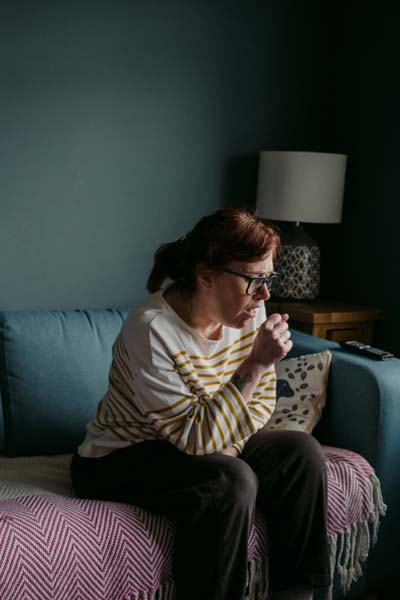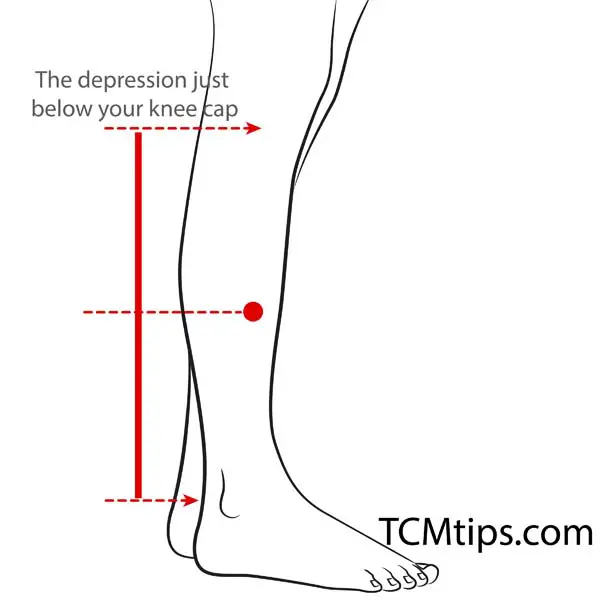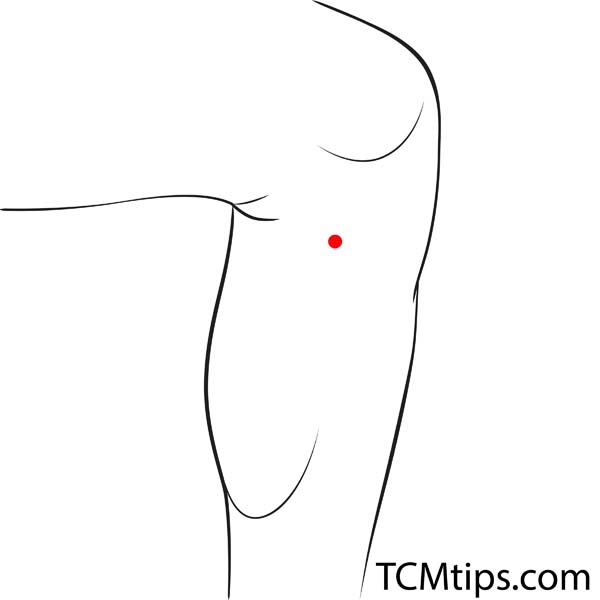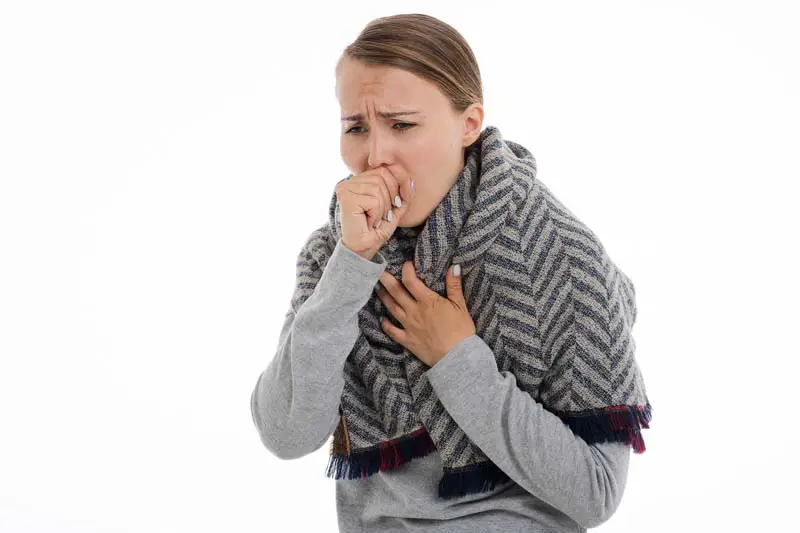Do you struggle with phlegm? Perhaps it is a bacterial infection that has been causing that nasty brown colored phlegm. Or maybe you notice a green or yellow colored phlegm. Whatever the color may be, we believe that you are looking for something that will help you eliminate it. But what may that be? Can perhaps acupuncture and acupressure help?
Can you relieve phlegm and improve your breathing by using simple acupressure techniques at home? Of course, you can! You just need to know the right acupoints that will make that possible, like the ST-40 acupuncture point. And that is precisely what we are here to tell you all about.
What causes phlegm?
 Phlegm is the medical term used to describe the mucus made in the chest. It is not usual for healthy individuals to produce such mucus. However, whenever we have a cold or struggle with an underlying medical issue, we start producing noticeable amounts of phlegm. Sputum is what doctors refer to phlegm, which the patient is coughing up.
Phlegm is the medical term used to describe the mucus made in the chest. It is not usual for healthy individuals to produce such mucus. However, whenever we have a cold or struggle with an underlying medical issue, we start producing noticeable amounts of phlegm. Sputum is what doctors refer to phlegm, which the patient is coughing up.
Over the years, doctors have seen different colored phlegm. They have successfully determined that the phlegm’s color is directly linked to its cause. Usually, we see green or yellow colored phlegm. This is a sign that tells us that the body is fighting an infection. Bronchitis and pneumonia are the two most common causes of green and/or yellow-colored phlegm.
Brown colored phlegm means that there is a presence of old blood within it. This type of phlegm can be caused by bacterial bronchitis, cystic fibrosis, lung abscess, and other causes. GERD, COPD, and even congestive heart failure cause an occurrence of white-colored phlegm. Black and clear phlegm can be present as well.
But enough about the causes, let’s see what is there to be done about it. It is important to know that each of the causes is treated accordingly, using proper techniques. One alternative technique, though, can help relieve phlegm as well. We are talking about the use of acupuncture and acupressure as a part of the treatment of phlegm.
Massaging these two acupuncture points at home can help reduce phlegm
1. Acupoint: ST-40 (Other Names: Stomach-40/Feng Long/Abundant Bulge)

The ST-40 acupuncture point stands for Stomach-40. This means that the greatest benefits of stimulating the ST-40 acupuncture point, by either using acupuncture or acupressure at home, will be linked to your digestive system, specifically your stomach. So, you may be wondering why we decided to include it in today’s list.
If we know anything about the many acupoints is that the majority of them are benefiting multiple body organs at the same time. And so, that happens to be the case with the ST-40 acupuncture point as well. Stimulating the ST-40 can help relieve the following health issues:
- Mild to more severe cough;
- Excessive phlegm;
- Asthma symptoms;
- Headaches;
- Dizziness;
- Epilepsy;
- Paralysis that affects the lower extremities, etc.
Talking about phlegm, the ST-40 acupuncture point has the power to transform the phlegm and dampness, stopping your cough and soothe your asthma. Daily stimulation of the ST-40 can help clear any phlegm, no matter the cause. There is a reason why the ST-40 acupoint is otherwise known as the Phlegm point. Its ability to resolve phlegm around the body is unlike anything that can be achieved by stimulating any other acupoint.
So, how to stimulate this acupoint? The ST-40 is located on the front of the lower leg. Measure approximately 10 inches superior to your lateral malleolus. Then, apply a two-finger width from the anterior crest of the tibia. This is the approximate location of the ST-40 acupoint.
Use the tip of your thumb to better locate the ST-40 and apply mild pressure. You may feel slight pain, but do not allow that to discourage you. Apply pressure for about 5 seconds and release. Repeat the steps ten times, treating the ST-40 acupoint on each leg. This acupoint may be easily stimulated by either applying acupuncture or acupressure. It can even be stimulated at home, for an instant phlegm relief.
2. Acupoint: SP-9 (Other Names: Spleen-9/Yin Ling Quan/Yin Mound Spring)

For the best possible effects, we would recommend combining the ST-40 acupuncture point along with the SP-9. SP-9 stands for Spleen-9. This is yet another acupoint located on your lower leg. But before we proceed to explain its location, first, let’s discuss its benefits. These are the greatest benefits achieved through regular stimulation of the SP-9 acupoint:
- Reduced edema;
- Improved diarrhea;
- Reduced genital pain;
- Improved urinary incontinence;
- Reduced abdominal pain;
- Reduced dampness, etc.
Like the benefits of the ST-40, the majority of the benefits of SP-9 revolve around the digestive, but also the urinary and reproductive system. There are some benefits to the respiratory system as well. As we mentioned earlier, stimulation of the SP-9 will result in reduced dampness. However, these effects will be enhanced once the stimulation of the ST-40 is applied as well. This is the ultimate combination that will help you eliminate phlegm.
SP-9 can be found near the knee. Use your thumb to locate the medial tibial condyle. Then, palpate the depression between the posterior and the inferior border of the tibia. This is where you will find the SP-9 acupoint. Now again, using your thumb, apply mild pressure for 10-20 seconds, and release. Repeat the procedure around ten times, stimulating the SP-9 acupoint on both of your legs. Acupuncture and moxibustion are possible.
Drinking this herbal tea may help as well!
While honey tea, ginger tea, and marshmallow root tea are all fantastic for soothing a nasty cough, we want to talk about the benefits of barley tea. Barley tea is not the usual herbal tea that we reach out to when we experience respiratory difficulties. However, that may be one of the greatest mistakes that we ever make.
Drinking two cups of the tasty barley tea can help break up phlegm, relieve cough, and even alleviate asthma symptoms. You will no longer battle a sore throat now that you have barley tea by your side. All you need are two cups of barley tea a day, and you are all set for a quick recovery. For the best possible effects, it is recommended that you combine barley tea with acupressure on the two acupoints that we discussed earlier.Conclusion
Experiencing phlegm is not pleasant. It is understandable why you would like to find a cure that works. And today you have found it. If you want to eliminate any phlegm by using alternative medicine, you came to the right place. Today we discussed the use of acupuncture points and barley tea as a way to treat phlegm and any additional respiratory issues. Follow the simple steps to accurately stimulate the two important acupoints and gain the benefits that are to come.
Related Reading
- DIY: Never Worry About Constipation Again With ST 25 Acupuncture Point And These 5 Other Points
- What Is It Like To Use Acupuncture For Bronchitis
Photo by Annie Spratt on Unsplash, Marcus Wallis on Unsplash

Try our Anti-Aging Gua Sha Tool designed to bring out your skin’s natural glow.
Best Gua Sha Product- Anti-Aging: The tool is designed to target 11 specific aging signs such as wrinkles and sagging skin. By following the 7-step routine, users can improve skin firmness and reduce fine lines naturally.
- Enhances Skincare Routine: It works effectively with serums and lotions, boosting absorption and efficacy of skincare products.
- Visible Skin Improvement: Users can expect a smoother complexion, reduced puffiness, and a more youthful appearance.
 P. Sze
P. Sze 

















